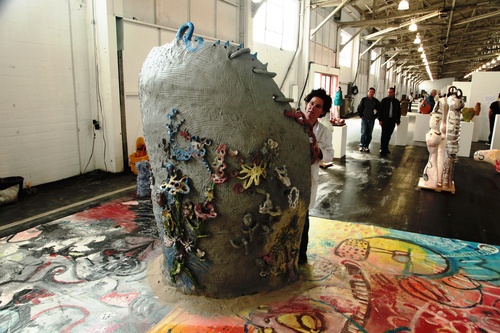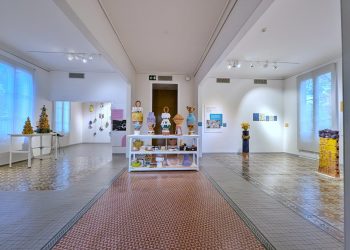Meditations on a performance in clay by Cybele Rowe and Lauren Ari
By Daniel Fleischmann
1. “Natural Great Piece” is an intricate, intimate, communal performance in the medium of clay. Like a dance or a concert, it is more overtly bound to time than most sculptural artwork, and it ends dissolved into the past.
2. Cybele Rowe and Lauren Ari make a large and detailed clay sculpture. It emerges from an improvisational score fed by their combined 60 years of art making experience. Passersby are invited to create self-portraits in clay to be incorporated into the artwork. Its surfaces become covered with these figures, which are painted with underglaze.
At a certain point, the construction is complete. Its size is such that it can easily conceal a large adult from view. The words of Tibetan lama Nyoshul Khen Rinpoche are carved into the unfired clay:
Rest in natural great peace this exhausted mind,
Beaten helpless by karma and neurotic thoughts
Like the relentless fury of the pounding waves
In the infinite ocean of samsara.
Rest in natural great peace.
A brief performance marks the culmination of the process. Then the Natural Great Piece is dismantled.
3. Rowe and Ari first manifested “Natural Great Piece” at the 2nd Ceramics Annual of America in San Francisco, October 5-9, 2011. They were joined by singer Bridget O’Keeffe and dancer Juliet Lin. In addition, roughly 250 fellow artists, ceramics aficionados, art students, and visitors contributed small figurative moments to the sculpture.
Circumnavigating its concave exterior or squatting in its embrace, you could see a red dragon, a female figure growing from yellow coral, a gnome pouring a jug of water over a balcony, a bloody ghoul, a colony of barnacles, a waiter bringing a head on a tray, a cluster of pink faces on a blue man’s torso, and countless more visual poems and paragraphs.
The chaotic and fascinating fresco captured the essence of the eternal cycle of birth, differentiation, suffering, death, and rebirth—in short, samsara. As varied as the details were, all came together in the single, curved wall. Reminiscent of both cave and womb, it described approximately three-quarters of a circle and measured about 3m in circumference, 2.5m in height at its apex, and 900 kg in weight.

4. There is no reason to believe that “Natural Great Piece” has a quintessential appearance. Rowe notes, for example, that the moisture in the air at Fort Mason, which sits on a pier above San Francisco Bay, forced her to build a stockier wall. One wing of the sculpture even threatened to collapse on Saturday, calling for quick reinforcement. In a drier clime, the taller shape could easily emerge given Rowe’s gift for stretching the proportions of clay.
For another example, because the venue was a ceramic conference, many participants were artists themselves. Rowe and Ari conceive of this work having an expression in a space where most passersby would not have artistic training. It would yield something quite different and perhaps more compelling to Ari, who says, “The point is that art is for everyone. Everyone gets to express. For me, it’s very powerful to invite people to art-making in a way that makes them say yes to the process.”
5. “How do you fire it?” is the number one FAQ. The answer is simple, but few can hear it without questioning further.
“So you’re not going to save it?”
“Then what are you going to do with it?”
“Are you going to take it apart and then fire it?”
You have to have compassion toward these reactions because it’s clear that great effort has gone into building this mother cave. The structural ingenuity, the input of so many people, even the cost of the clay—surely it must be saved.
But when a saxophonist stops blowing, or a monk rises from a meditation of pure surrender, or a trick pilot pivots a plane like a beached fish in midair and then recovers, nobody questions why the transcendent emergence has to end. Nobody asks the pilot, “How will you save that moment?” And even fired clay is only a pause in this fluid reality.
(The second most common question is asked by people who have given Rowe and Ari their clay self-portrait: “Where is the piece I contributed?”)
6. Last summer, Ari and Rowe got together at Rowe’s studio in the hills southeast of L.A. Together, they built two small structures to explore the way their languages combine. They also painted two large drop cloths in prismatic colors to serve as a foundation for the sculpture. Their daughters, Galatea and Mirabai, fast friends, played together while their mothers worked.
The artists first met the previous year at the First Ceramics Annual, but even before that, Ari had seen Rowe’s work and recognized a kindred spirit. “When I saw [it], I thought to myself, ‘If I were to make something big, I’d want it to look like that.”
Rowe had also been instantly attracted to Ari’s work and had actually set one of Ari’s images as her computer’s desktop graphic before the two ever met.
“So when we met, we quickly started talking about collaboration,” Ari relates. “We had similar energy and ideas.” Over the year, these ideas coalesced, leading them to Fort Mason on October 5, 2011, where they spread the canvases, poured a ring of sand for a base, and began to grow the artwork from the ground up.

7. It is a secret den inside the sculpture, child’s hideout, where you might get away from regular life and be somebody else for a while. One woman who enters the sculpture sings pure tones into it, exploring how each one resonates. Some people tentatively press a finger against a wall to test its solidity or to feel the vitality of the wet clay facing them at eye level.
This is clearly not sculpture alone. There are certain expectations about clay and how it gets treated whether it’s coming out of a riverbank, being worked in a pottery class or on display at an art exhibition. There are certain common opinions about what clay is and what it can do. “Natural Great Piece” gently ignores most of these. Meanwhile, the artists who work on it from Thursday through Sunday wear monogrammed lab coats as though involved in some weird science experiment.
“Love the questions,” said the poet Rainer Maria Rilke.
8. As she works texture into the clay that now surpasses her height, Rowe improvises a description without a pause: “We’re making a collaborative, interactive artwork that is a performance happening over three days. It culminates with a dancer and a singer performing around and inside of it. It is about beauty and storytelling. It is unfired and has something to do with the fragility of being human.”
Rowe’s description is surprisingly matter of fact—surprising because the experience of “Natural Great Piece” is so unlike anything else at the show. While many artists work intuitively and collaboratively, there aren’t many places in the art world where the surrender to process is so complete.
9. Then there’s the question of value. As working artists, Rowe and Ari share the eagerness of every artist at the Ceramics Annual to make money from their passion. But “Natural Great Piece” rises from the exhibition floor into an uncertain relationship to the commerce of clay. The business of art is strange enough compared to the production and sale of rubber washers, motherboards, corn tortilla—prosaic widgets like that. This piece feels even stranger. To buy it would be to purchase both its creation and its destruction. You would be paying for the singer’s song, the dancer’s dance, and the input of 250 anonymous artists—and in the end, you would have no sculpture. You would be buying the experience and the right to film. Clay collectors might not be the audience. Perhaps theater sponsors would be more likely to support an emergence of “Natural Great Piece.” Or maybe the St. Louis Chamber of Commerce or Beijing City Hall would commission the work for some civic event.
10. All day Saturday and Sunday, planes roar through the air above Fort Mason. Trick fliers from around the world have come to town. It’s Fleet Week in San Francisco, and mobs of people pack all the piers, the park, and the parking lots to see the air show above the bay. In truth, the Ceramics Annual does not register for most visitors to San Francisco this weekend.
The noise of the jets permeates “Natural Great Piece.” Maybe it’s what compels Ari to spend so much time within the sanctuary of the structure inventing the intricate stories there. Perhaps it spurs Rowe to build the wall high and thick as she marvels at the cost of the jet fuel burned up for the sake of entertainment.

By some grace, the sound of planes does not interrupt the culminating performance on Sunday. On that afternoon the headline act of the air show, the world-famous Blue Angels, cancel after just one high-speed fly-by. The weather is deemed too foggy for safety. Which is San Francisco for you. As the crowd begins to disperse, there is a sudden influx of visitors to the Ceramic Show. But by then “Natural Great Piece” is already coming down.


11. On Sunday, October 9 at about 1 p.m., Rowe and Ari stop adding to the structure. A hand gong sounds nearby. The shake of a rattle. Bridget O’Keeffe generates a slow rhythm as she and the dancer Juliet Lin move deliberately through the gathered audience, arriving at the edifice, and within the frame of filmmaker David Silberberg’s camera.
O’Keeffe sits inside the sculpture on a low stool—a tuffet, I want to call it—and it becomes an opera shell, its acoustics sending her operatic voice into the surrounding space. Lin circumnavigates the structure multiple times in a slow Butoh-style step. “This image is of Buddha walking on Lily pads across a pond,” Lin explained to me later. “I feel meditative when I use that walk. I also hope the audience begins to join me in a sort of meditation, which can lead to a sense of oneness between the audience and the performance.”
At length, O’Keeffe begins to sing the words and phrases of the Rinpoche quote while Lin enters different phases of her dance including a fetal crawl, a herky-jerky abandon and, near the end, a beautiful dervish rotation. When the performers reach a mutual silence and stillness, the audience applauds.
The word that keeps coming to me is grace. Both performers embody it, as do the contours and chaos of the sculpture. (Silberberg’s film runs approximately 16 minutes.)
12. At about 2:30 on Sunday, the denouement begins unceremoniously. Rowe takes a clay cutter and begins to slice the wall into chunks that are tossed back into the plastic bags from whence they came. By 5, nothing remains.
13. The clay is donated to the National Institute of Art and Disabilities in Richmond, California, where Ari works as an instructor. NIAD provides a visual arts studio program for adults with developmental and other disabilities. The clay will be made into other forms, perhaps a vase that might be fired after all. It could be sold at the NIAD store, filled with flowers and set on a table, serving for years until one day, an earthquake or a rowdy Doberman topples it from a shelf, and it shatters on a slate floor.
That’s how “Natural Great Piece” is: huge and nebulous but also intricate and finely specific. It is a celebration of inclusion, of yielding, of not knowing. It is an open-ended dialogue about surrendering to the song that pours through you, and through us all.
Daniel Fleischmann is a poet, writer, performer, musician, writing teacher and copywriter in California’s Bay Area.
Published in Ceramics Now Magazine Issue 2.
Visit Cybele Rowe’s and Lauren Ari’s websites.


















